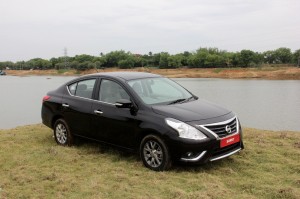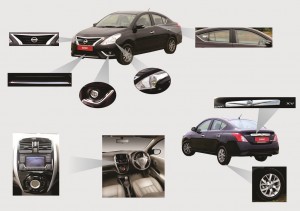Text & Photos: Bhargav TS
 Nissan Motor India unveiled the latest version of Sunny at the 2014 Auto Expo. When Sunny was launched in India in 2011 the car lived up to expectations in terms of space, style and price, with a choice of diesel and petrol engine options. The big USP of Sunny is its roomy interior especially at the rear. You can cross your legs comfortably sitting in the rear even when the front seats are fully pushed back; because of this it has been the best-selling car for Nissan India, generating consistent decent sales numbers and has managed to compete effectively with the likes of Volkswagen Vento, Hyundai Verna and Honda City.
Nissan Motor India unveiled the latest version of Sunny at the 2014 Auto Expo. When Sunny was launched in India in 2011 the car lived up to expectations in terms of space, style and price, with a choice of diesel and petrol engine options. The big USP of Sunny is its roomy interior especially at the rear. You can cross your legs comfortably sitting in the rear even when the front seats are fully pushed back; because of this it has been the best-selling car for Nissan India, generating consistent decent sales numbers and has managed to compete effectively with the likes of Volkswagen Vento, Hyundai Verna and Honda City.
Therefore, in the latest variant of Sunny, Nissan has untouched its mechanicals but slightly updated the interiors by borrowing the dash from the refreshed Micra. So what is new in the 2014 Sunny? The answer is chrome filled exteriors with new, larger headlamps and grille. The novel boomerang shaped headlights and trapezoid grille confirm to Nissan’s new global design philosophy. The exterior of the car is dominated by a lavish chrome accent with newly designed bumpers and fog lamps that extend the style quotient further.
The Front
The front bumper looks solid and features the fog lamp housing, which too has some chrome treatment at the lower end with a chrome lip on the central air dam, present in the top variant, to give the car a more premium look. The side profile remains the same, except for a new chrome outfit at the corners of the window line end. The ORVM now features integrated turn signals and two tone treatment with a combination of body color and black. The 12-spoke wheels are brand new featuring what Nissan calls the ‘Y shaped design’.
The Rear
Moving towards the rear, the apparent changes include a new chrome garnish over the license plate and a new rear bumper. The new bumper flows with the existing shoulder line, protrudes outward and accommodates reprofiled wrap-around tail lamps. The antenna is now shorter and has been moved to the rear end of the roof to look sportier.
The Inside
The Japanese auto major has also added some chrome to the interiors to give a premium feel inside the car. The dashboard is redesigned and fitted with piano black centre console, which has chrome-lined dials and silver accents. The top variant of the Sunny facelift also gets a 2-DIN audio system with a 5.1-inch display which also shows the reversing camera. There is a new steering wheel with new audio controls that are finished in chrome and wrapped in leather to give the interiors a quality look. Other features include Bluetooth connectivity and AUX and USB ports, which are now placed above the glove box for better accessibility.
Powerhouse
Mechanically, the Sunny has not been fiddled with; it is still powered by either a 1.5 litre petrol engine that develops 99 PS of power and 134 Nm of torque or a 1.5 litre diesel engine that develops 85 PS and 200 Nm of torque. Both the engines are mated to 5-speed manual gearboxes; the petrol engine though is also offered with an XTronic CVT. The petrol engine with the manual gearbox gives 16.95 kmpl whereas with the CVT it delivers 17.95 kmpl. The diesel engine has improved in terms of fuel-efficiency because with ECU remapping, the fuel-efficiency figure now stands at 22.71 kmpl as compared 21.64 kmpl earlier. A company official said, “We received lot of response for the Sunny diesel version and the customers looked for better fuel efficiency. Therefore, to improve the diesel engine’s fuel efficiency, we have marginally optimised and balanced the ECU mapping. This resulted in achieving better fuel efficiency without compromising the power and torque output of
the engine.”
The Drive
The Sunny absorbs the bumps and potholes in the road quite easily and even really bad patches only cause some amount of juddering. The NVH levels have been improved as well and it has a quieter cabin than before. The 1.5 K9K engine is a proven powerhouse that offers good low end torque but one needs to shift gears quite often to stay in the power band. The diesel engine has adequate performance for city and highway conditions and the Sunny has no problems when crossing triple digit speeds. The clutch is much lighter than the outgoing Sunny and feels comparatively light during city driving.
Nissan emphasises more on safety features and offers driver airbag, ABS and EBD as standard in all variants. A front passenger airbag is offered on the top-end XV variant of the diesel, while the range-topping XV Premium Pack 2 comes with side airbags as well. The refreshed Sunny has a bold new design, additional chrome and new features that make it stand out in the crowd. It looks more premium than the outgoing model, and should appeal more to prospective buyers. The big worry for Nissan India is the after sales service, which they are now handling independently and planning to expand to 200 touch points before end of this year; this should increase consumer traffic to their showrooms and help the brand to grow.












Leave a Reply